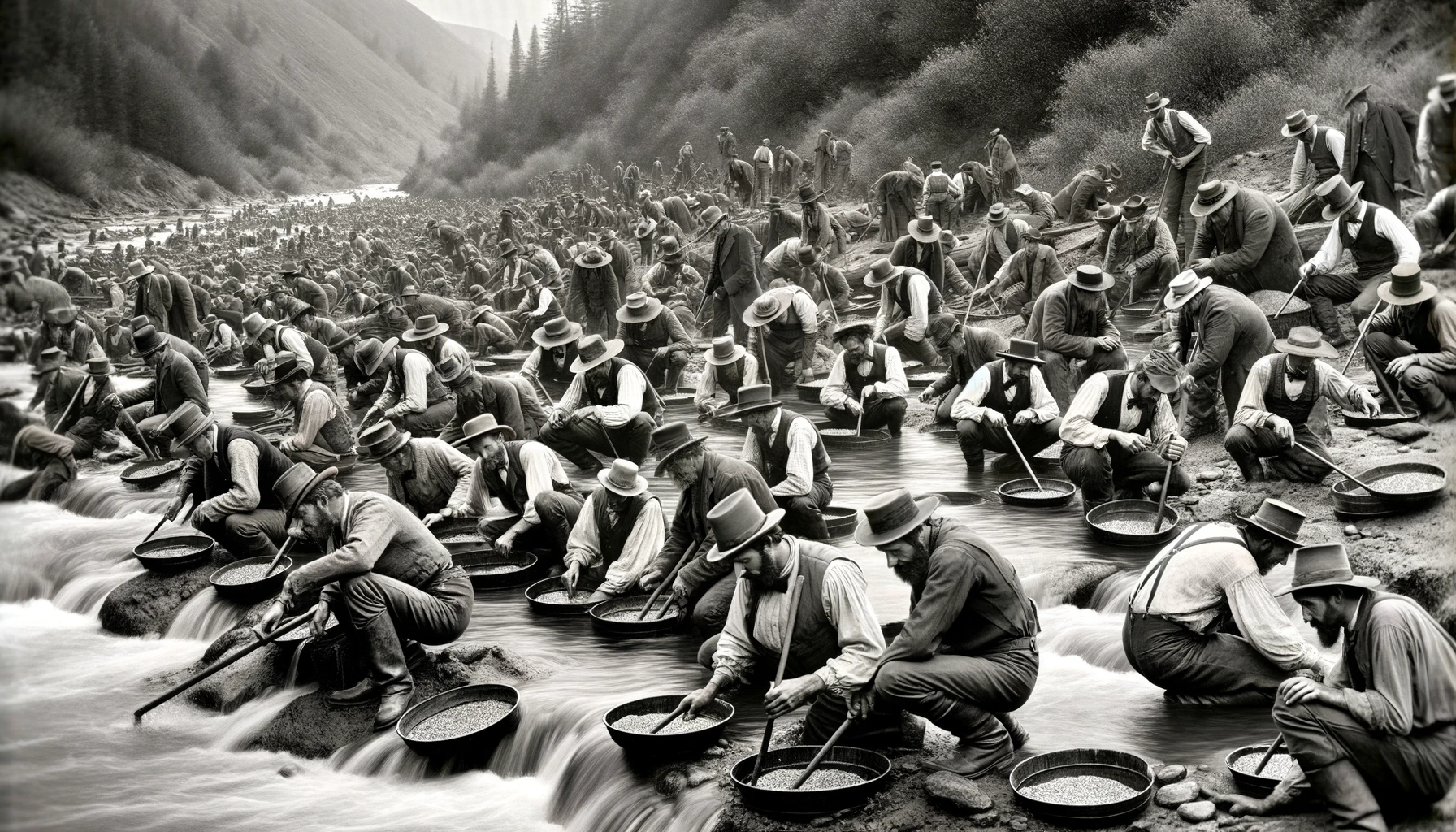Content is Everything
Gold Rushes were a prominent feature of the second half of the 1800s. In almost any part of the world, a story would spread of some prospector striking it rich somewhere; and the next thing you know, a gazillion people were crowding the same riverbank hoping they too could fossick their way to a fortune.
Note that it was only a story that was required. Nobody had to meet the lucky prospector in person, they only had to hear about their success and discover how they did it.
In the case of gold panning, the process is attractively dead easy. Use the lip of your pan to scoop out some gravel from a flowing creek. Allow the running water to wash away the mud. Swirl the remaining contents around the pan and look for flecks of gold. If nothing shiny catches your eye, toss the contents of the pan back in the creek and try again. That’s it.
If you want to strike it rich gold panning that’s the precise process you must follow. No successful gold panner ever did it any other way. Therefore, logic dictates that if you want a fortune-creating flash in your pan, you must follow this process exactly.
If you ever find yourself caught up in a gold rush and you start doubting yourself, just look around you and see all the other gold panners also slavishly following the same process. If they are doing it, then it must be the right thing to do. Trust the process and just keep panning.
This article is about another kind of gold rush; a modern, very technological kind of gold rush. This article is about digital media; in particular, corporate marketing and communications.
Happy Birthday, Mr Zuckerberg
It was in 2003 that a notably socially-awkward university student created a website that allowed fellow Harvard frat boys to rate the hotness of female students. Mark Zuckerberg achieved this milestone by stealing pictures of the girls from the university’s intranet student directory.
As addictive as it was unethical, the site was relaunched in February 2004 as TheFacebook, and, well, you know the rest.
What this means is:
social media is twenty years old
Please take a moment to let that sink in. Social media is mainstream media. It’s pretty much legacy media. It’s no longer some mysterious cash generator that only kids truly understand. Social media is very much old hat. Yes, even TikTok.
For the corporate world today, social media should be considered merely just another channel for organisations to communicate with customers, and hopefully generate leads. However, there is a powerful narrative that is encoded within the promise of social media that modern-day marketers are seemingly unable to shake.
When it first started, social media was a genuine game-changer for both users and corporate early adopters.
Social media allowed people with very specific identities and mostly-harmless proclivities to discover like-minded compatriots from all over the world. Whole micro-communities were formed. Many people who previously felt outcast were being united by common interests. For a time, the world seemed both smaller and more transparent and open.
However, by using the service, social media users were openly communicating to the world who they really were. They were self-sorting into very, very granular demographics.
Social media paid a lot of lip service to privacy and the appearance of anonymity, but its typically unread terms of service states you agree to sharing the data of your every mouse click and keystroke. And, that data could be sold to third parties.
Which meant, for the first time, advertisers could direct their messages in extremely targeted ways.
What was intoxicating to marketing departments was the chance to both drastically minimise the wastage of media spend by creating custom content for micro markets.
It meant businesses could genuinely become the content. And in those early days, that content could be almost anything.
The corporate social media gold rush started something like this: An intern sitting in a mailroom somewhere opened a company Facebook account and uploaded a couple of cat memes to it, triggering a tidal wave of orders, seemingly out of nowhere.
It didn’t take long for the accountants to catch on. When they realised they could halve their marketing & sales departments, set their ad agency adrift, and drastically slash their media spend… well, that’s when gold fever really took hold.
Process is nothing
But, once again, all that was decades ago. The novelty soon became mundane. The micro communities became too large and too swamped by bad actors, bots and spam.
Everyone moved on. The young people who got the whole thing going are probably themselves the VPs of Marketing at some multi-national conglomerate.
And while the dream of striking it rich still pervades, with occasional eureka moments; the old stream just ain’t givin up them nuggets like it used to.
These days, what we have is businesses following the same old process, but getting very little in return. The overwhelming majority of corporate social media feeds is textbook parity gridlock.
What this means is you can no longer simply look around at what your competitors are doing and copy them. Just like gold-panning, the process is mandatory, but process alone will not guarantee your success.
If you can’t think beyond process, all you’ll be is just another marketer, down at the creek stirring up mud, while your boss watches from the bank, waiting for you to hit pay-dirt that was extracted years and years ago.
A Vessel Half Empty
To put all this in proper perspective, you have to look beyond the hype. All social media has ever been is infrastructure. Just like the website gold rush that happened a decade before it, social media is only a vessel with which you have to fill with content.
All the promises made, all the hype about the algorithm, and the stories of riches and wealth come with a tiny caveat at the bottom of the contract that you need a well-lit room and a magnifying glass to read:
*We only supply the infrastructure, you supply the content.
Sure, the infrastructure is truly amazing. Powerful, efficient, transformative… a Silicon Valley engineer’s wet dream. But it’s still only infrastructure.
The creative part is wholly up to you.
It’s very easy to gloss over that point. Very easy to become caught up in all the peripheral noise around social media. But this is precisely what is happening with so many businesses.
Just look at the job ads that talk about analytics, CMS, scheduling, metrics, SEO, blah blah blah. It’s all ‘picks and shovels’. It’s all process and virtually nothing about content.
You Built It, But No One Came
What constitutes social (and EDM and Internal) content for many organisations these days is mostly irrelevant drivel. Positive working culture is often imposed by management mandate, and even the most well-meaning content is merely quietly tolerated by team members. You must know, deep down, that no employee actually believes in your corporate values.
Meaning: nobody in your team is going to imperil their job by standing up and saying “our social media sucks”.
Much of corporate social media content is merely what I call tweed. And you can see plenty of examples of it on my post about tweed, here.
I’m concluding businesses must be happy with this kind of non-content. I don’t know why, because it is certainly, wholly and completely ignored by real people.
If you don’t believe me, your very own social media feed is screaming at you when your views and likes barely make it to double digits.
Maybe managers actually do see social media as some kind of internal communications channel? But why then do I see so many businesses advertising for social media managers? Surely they must be chasing something?
The Enduring Promise Of Digital Media
So far, I’ve been talking about social media; but I’d like to include websites and emails from here on in, and refer to the whole thing as digital media.
Sure… if you have got to here, you could be excused for thinking I’m a grizzled old coot shaking my fist at the sky. And you may well be right.
But what I just can’t shake is the knowledge that these channels all have so much more potential than how they are being used today. In spite of all my cynicism, I’m still a believer.
There are businesses which are, to this day, generating great results online. Businesses that go beyond copycat process. Businesses that are simply delivering great content.
Now, I could put a simple list here of all the things that great content actually is… but two things will happen:
- You will skim over it and not properly appreciate its profundity
- ChatGPT et al will plagiarise it and present it to others without attribution.
Oh, alright. But only if I can preface this by saying this is billion dollar advice I’m giving you. Here goes:
- Make the subject of your digital media content about your customers and/or prospects. Talk about them much more. Talk about you much less;
- Make that content as useful, relevant, interesting, entertaining, educational and as fun as possible… for them;
- Try your utmost to make the content sharable.
Share-ability is by far the number one, hidden-in-plain-sight, secret-to-success factor in content creation for digital media.
Print the following words in bold on an A3 page and stick it front of anyone who calls themself any kind of content creator:
if it‘s not sharable, it’s not content
Reminding yourself of this fact is your reward for coming this far. It is the equivalent of a massive gold nugget in your pan, shining at you… right now.
The potential power of digital media, social especially, is its network effect.
In the early days, people shared cat memes because it was novel and fun to do so. The content was all of the things I listed above, but the true joy came from the act of sharing.
While social media deservedly warrants some very stern criticism, especially for the sheer cultural havoc it is wreaking upon populations of the credulous; it is, nonetheless, an incredibly amazing bit of engineering. As a hammer is made to hit nails, social media is designed to build audiences.
And sharing is how the building is done. Sharing is (at least, should be) what digital media is all about. Just as time on page is the only true SEO metric worth worrying about, sharing is the must-have, key ingredient that makes digital media work. If your content isn’t at least attempting to be sharable, you have almost precisely nothing.
Know It When You See It
Here’s a rough-draft content sample I created as a pitch to a regional bank. Based on my three bullet points above (and, putting whatever stylistic sensibilities you have aside), see if you think it qualifies as “content”.
In Conclusion
The fact remains, digital (especially social) media is branded as something that “only young people understand”.
To be fair, if you’re a business owner or accounts manager, I can see why you would conclude that the investment in social media content isn’t worth the 13 likes that it generates, which are mostly from other staff members anyway.
I can see why you wouldn’t want to spend more money on your website, when you know most people who visit it are from a country you have never heard of.
I know why you’re reluctant to spend hours creating marketing mailout content that only gets a handful of opens.
Therefore, I totally get why you think the task of digital media creation and management is best assigned to a “co-ordinator” (aka: a lowly-paid junior).
But you truly would be missing out.
If you owned a brewery that got all the finance, logistics and marketing infrastructure in place… but left the actual content creation to your most inexperienced junior employees, you’d expect to go out of business really quickly, right?
Digital media still has fantastic lead-generating potential. There’s still very real returns on investment. There’s still fortunes to be made with great stories, well told.
As long as you understand that:
- the fundamental rules apply
- ideas matter
- content truly is king
If youth is wasted on the young, then very definitely, so is digital media.





